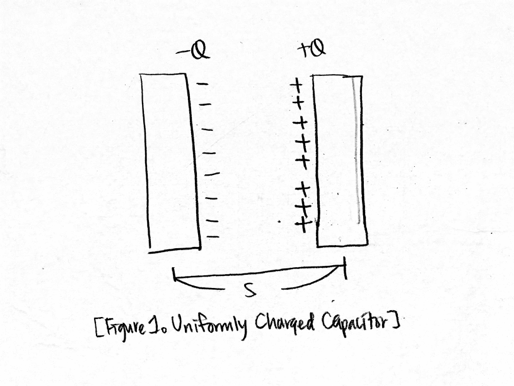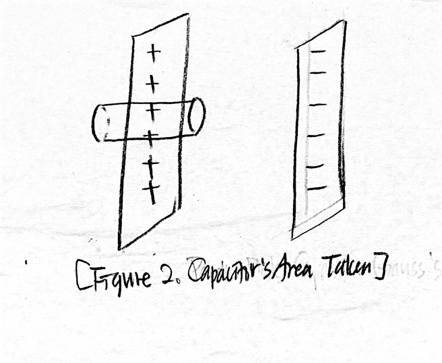Charged Capacitor: Difference between revisions
| Line 10: | Line 10: | ||
The mathematical model to the electric field of a charged capacitor (near the center of the capacitor) is <math>E \approx {\frac{Q/A}{{\epsilon}_0}}</math>, where '''Q''' is the magnitude of the plate charges and '''A''' is the area of each plates. The direction is perpendicular to the plates. | The mathematical model to the electric field of a charged capacitor (near the center of the capacitor) is <math>E \approx {\frac{Q/A}{{\epsilon}_0}}</math>, where '''Q''' is the magnitude of the plate charges and '''A''' is the area of each plates. The direction is perpendicular to the plates. | ||
<br>The fringe field (field located near the center of the disks but right outside of the plates) is <math>E_{fringe} \approx {\frac{Q/A}{2{\epsilon}_0}} (\frac{s}{R})</math> | <br>The fringe field (field located near the center of the disks but right outside of the plates) is <math>E_{fringe} \approx {\frac{Q/A}{2{\epsilon}_0}} (\frac{s}{R})</math> | ||
<br> | |||
====Derivation==== | ====Derivation==== | ||
[[File:Capacitor111.png]] | [[File:Capacitor111.png]] | ||
| Line 16: | Line 16: | ||
<br><br>Then, the contribution of the negative capacitor is <math>E_- \approx {\frac{Q/A}{2{\epsilon}_0}} [1-\frac{z}{R}]</math> (to the left) and the positive capacitor is <math>E_+ \approx {\frac{Q/A}{2{\epsilon}_0}} [1-\frac{s-z}{R}]</math> (to the left). | <br><br>Then, the contribution of the negative capacitor is <math>E_- \approx {\frac{Q/A}{2{\epsilon}_0}} [1-\frac{z}{R}]</math> (to the left) and the positive capacitor is <math>E_+ \approx {\frac{Q/A}{2{\epsilon}_0}} [1-\frac{s-z}{R}]</math> (to the left). | ||
<br>If we add up the contributions, <math>E_{total} \approx {\frac{Q/A}{2{\epsilon}_0}} [1-\frac{z}{R}] + {\frac{Q/A}{2{\epsilon}_0}} [1-\frac{s-z}{R}] \approx {\frac{Q/A}{{\epsilon}_0}} [1-\frac{s/2}{R}]</math>. Since s <math>\ll</math> R, <math>E \approx {\frac{Q/A}{{\epsilon}_0}}</math>. | <br>If we add up the contributions, <math>E_{total} \approx {\frac{Q/A}{2{\epsilon}_0}} [1-\frac{z}{R}] + {\frac{Q/A}{2{\epsilon}_0}} [1-\frac{s-z}{R}] \approx {\frac{Q/A}{{\epsilon}_0}} [1-\frac{s/2}{R}]</math>. Since s <math>\ll</math> R, <math>E \approx {\frac{Q/A}{{\epsilon}_0}}</math>. | ||
<br> | |||
====Gauss's Law==== | ====Gauss's Law==== | ||
[[File:CapacitorII.png]] | [[File:CapacitorII.png]] | ||
Revision as of 04:25, 17 April 2016
CLAIMED BY: GA HYUN OH
The Main Idea
A capacitor is when two uniformly, but oppositely (-Q and +Q), charged metal plates are held very close to each other with a separation of s.
This page is dedicated to understanding and calculating the electric field of a capacitor through definition, mathematical models, computational models, and example problems.
A Mathematical Model
The mathematical model to the electric field of a charged capacitor (near the center of the capacitor) is [math]\displaystyle{ E \approx {\frac{Q/A}{{\epsilon}_0}} }[/math], where Q is the magnitude of the plate charges and A is the area of each plates. The direction is perpendicular to the plates.
The fringe field (field located near the center of the disks but right outside of the plates) is [math]\displaystyle{ E_{fringe} \approx {\frac{Q/A}{2{\epsilon}_0}} (\frac{s}{R}) }[/math]
Derivation

Take the origin at the surface of the left plane, with the z-axis running to the right. We assume that each disk has a uniformly charge density (s [math]\displaystyle{ \ll }[/math] R).
Then, the contribution of the negative capacitor is [math]\displaystyle{ E_- \approx {\frac{Q/A}{2{\epsilon}_0}} [1-\frac{z}{R}] }[/math] (to the left) and the positive capacitor is [math]\displaystyle{ E_+ \approx {\frac{Q/A}{2{\epsilon}_0}} [1-\frac{s-z}{R}] }[/math] (to the left).
If we add up the contributions, [math]\displaystyle{ E_{total} \approx {\frac{Q/A}{2{\epsilon}_0}} [1-\frac{z}{R}] + {\frac{Q/A}{2{\epsilon}_0}} [1-\frac{s-z}{R}] \approx {\frac{Q/A}{{\epsilon}_0}} [1-\frac{s/2}{R}] }[/math]. Since s [math]\displaystyle{ \ll }[/math] R, [math]\displaystyle{ E \approx {\frac{Q/A}{{\epsilon}_0}} }[/math].
Gauss's Law

Say [math]\displaystyle{ \sigma }[/math] is the surface charge density, and the area on each side of the cylinder is A.
Since Gauss's Law is [math]\displaystyle{ \Phi = \lmoustache \vec{E} \cdot d\vec{A} }[/math], [math]\displaystyle{ \Phi_{left} }[/math] = 0, [math]\displaystyle{ \Phi_{circular sides} }[/math] = 0, and [math]\displaystyle{ \Phi_{right} = \frac{Q_{enclosed}}{\varepsilon_0} }[/math]; while [math]\displaystyle{ \vec{E}_{left} = 0 }[/math], [math]\displaystyle{ \vec{E}_{circular sides} \perp \vec{A} }[/math].
Thus, EA = [math]\displaystyle{ \Phi = \lmoustache \vec{E} \cdot d\vec{A} }[/math] = [math]\displaystyle{ \Phi_{right} = \frac{Q_{enclosed}}{\varepsilon_0} }[/math] = [math]\displaystyle{ \frac{\sigma A}{\varepsilon_0} }[/math]. Therefore, E = [math]\displaystyle{ \frac{\sigma}{\varepsilon_0} }[/math]
A Computational Model
Uniformly charged capacitors can be further explored through PhET Interactive Simulations. Here, the user can explore how a capacitor works by changing the size of capacitors and add different objects such as dielectrics to observe how they affect capacitance.
Charged capacitors can also be visualized through this vpython code created on the website Teach hands-on with GlowScript
Examples
Be sure to show all steps in your solution and include diagrams whenever possible
Simple
Middling
Difficult
Connectedness
- How is this topic connected to something that you are interested in?
- How is it connected to your major?
- Is there an interesting industrial application?
History
Put this idea in historical context. Give the reader the Who, What, When, Where, and Why.
See also
Are there related topics or categories in this wiki resource for the curious reader to explore? How does this topic fit into that context?
Further reading
Books, Articles or other print media on this topic
External links
Internet resources on this topic
References
This section contains the the references you used while writing this page